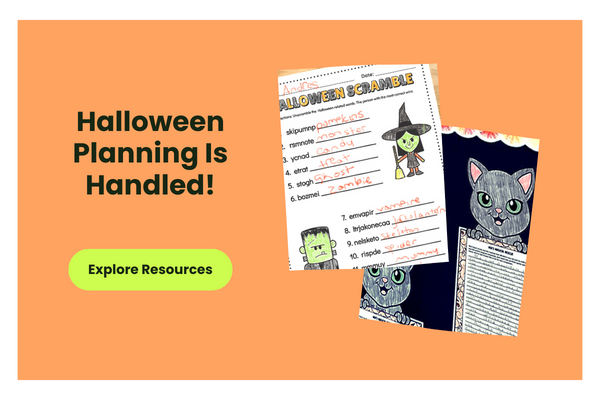Halloween science experiments for kids never fail to spark some magic during the spookiest time of year! Perhaps it’s because the ‘mad scientist’ vibe just goes so well with the spookiest time of the year?
Whatever the reason Halloween science activities deliver on everything you want a STEAM activity to provide for your pupils: Helping them develop their inquiry skills, demonstrating the scientific method and plenty more.
Are you ready? The teacher team at Teach Starter is going to show you how easy it is to develop science inquiry skills with a pumpkin and provide you with fun ideas to get supremely slimy and complete more Halloween science that will have your pupils in stitches (not literally, we hope!).
Read on for some truly fun science experiments with a Halloween twist to hook your class on learning.
Halloween Science Experiments for Kids
1. Make a Pumpkin Volcano!
Let’s start with an experiment that’s sure to create a wow factor in your science class — the pumpkin volcano.
This experiment takes the classic volcano STEM activity and adds a Halloween element. You’ll use bicarb soda and vinegar — and a pumpkin, of course — to create an awesome Halloween chemical reaction!
How to Make a Pumpkin Volcano:
- Hollow and deseed a medium-sized pumpkin.
- Add 828 ml of white vinegar, 240 ml of water, 10 ml green food colouring, 20 ml dishwashing liquid into the pumpkin.
- In a separate bowl, mix 240 grams bicarb soda and 240 ml water. Stir very well until dissolved.
- Pour the bicarb soda and water solution into the pumpkin mixture. Stand back!
Please note that ratios may vary. The ratios outlined are ideal for a medium-sized pumpkin.
As much fun as they’ll have enjoying the spectacle of this big mess, it’s important for children to explore and begin to understand the science behind it. So here’s the spooky science behind this chemical reaction:
- The bicarb soda (sodium bicarbonate) is a base, while the vinegar (acetic acid) is an acid.
- Sodium bicarbonate and acetic acid react together to form carbonic acid which is very unstable.
- The carbonic acid instantly breaks apart into water and carbon dioxide.
- The carbon dioxide creates impressive fizzing as it escapes from the solution.
2. Complete a Spooky Slide or Roll Science Investigation
Are you and your pupils exploring movement this month? If so, this could be the right Halloween science experiment for you!
This Halloween STEM activity encourages pupils to observe the way different shaped objects such as balls, blocks and pumpkins move. Your young scientists are encouraged to discuss how the movement of an object depends on a variety of factors, including its size and shape.

This Halloween science experiment is an excellent opportunity to encourage higher-order thinking:
- What familiar objects roll and slide? Do you know of any objects that do both?
- How could we test whether an object rolls, slides, or does both?
- Is it a Fair Test?
- In what ways could we record our results?
- How does the shape and size of the object affect how it moves.
3. Find Out Whether a Pumpkin Will Sink or Float?
In this Halloween-themed science experiment, students explore how push and pull forces affect how an object moves in water!
Pupils will investigate and observe the concept of buoyancy and get an understanding of what objects sink and what objects float … and what it is that makes a pumpkin do one or the other.

Teach Starter Teacher Tip: Walk your students through the scientific method. Then, as a class, follow the five steps of the scientific method:
-
Look at the world
-
Ask questions
-
Make a prediction
-
Write or draw what happens
-
Share findings
So why do objects float? Whether an object floats or sinks is determined by the balance between the downward pull of gravity and the upward push of the water.
If the upward push of water is greater, an object will float. If the downward pull of gravity is greater than the upward push of the water on the object, the object will sink.
4. Make Pumpkin Slime
This Halloween activity is, well, just gross, and your pupils will totally love it! Amaze them with some slimy science facts! Did you know that slime:
- Is a liquid, but not a regular liquid — it’s known as a non-Newtonian fluid
- Flows like a liquid, but unlike familiar liquids (e.g. oil and water), its ability to flow or viscosity is not constant.
- Is made of chemicals that are mixed to form polymers. The polymers act as a net, with molecules sliding against each other.
For this slime recipe, you will need:
- small pumpkin for each student group
- 60 ml liquid starch
- 120 ml white school glue
- 120 ml water
For more slimy fun, try this fun colour-changing slime experiment!
So, as you can see, Halloween science experiments and investigations are a whole lot of fun! Most importantly, these experiments offer a rich learning experience and a chance to practise the scientific method.









Comments